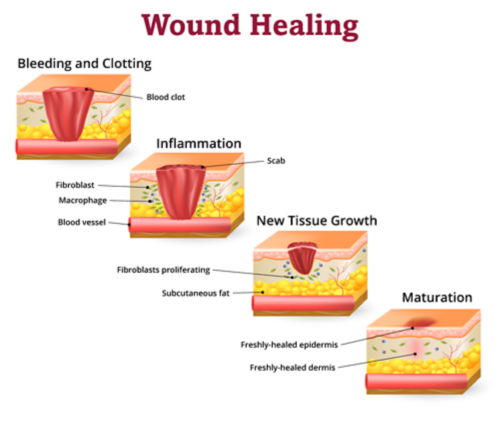What is delayed wound healing?
Delayed wound healing occurs when a wound or break in the skin takes longer than normal to heal. During cancer, delayed wound healing can occur because of changes to the skin, blood cells, blood vessels, and immune system.
For children with cancer, examples of wounds that might not heal properly include surgical incisions, pressure sores, device sites such as feeding tubes or central lines, and cuts or abrasions. Wounds that heal slowly can cause pain and discomfort, increase risk of infection, and even delay cancer treatments.
Stages of wound healing
Wound healing occurs through a series of steps or phases. In general, these include:
- Bleeding and clotting – The flow of blood is slowed through constriction of blood vessels and clotting. Platelets in blood are activated and stick together to slow and stop bleeding.
- Inflammation – White blood cells travel to the injury site to get rid of dead cells, germs, and debris. Cell messengers called growth factors signal for new tissue to start growing.
- New tissue growth – New blood vessels, collagen, and skin cells begin to grow, and the edges of the wound are pulled together.
- Maturation – The new tissue becomes stronger and less fragile.
The skin normally has a remarkable ability to heal itself. However, even when skin heals properly, the damaged or scarred area does not have the full strength of skin that was never injured.
Cancer treatments and wound healing
Cancer treatments can often lead to slow or incomplete healing of wounds. Understanding how treatments may affect skin and healing can help families prepare for possible side effects and better manage wound and skin care.
Chemotherapy and wound healing
Chemotherapy can cause a variety of side effects that affect the skin and its ability to heal. These include:
- Skin irritation and sensitivity
- Sores and tissue damage around the IV site if chemotherapy is given through a vein
- Decrease in blood flow to the wound site
- Decrease in collagen production
- Decrease in skin strength
Effects of chemotherapy on wound healing depends on several factors such as the dose, frequency, duration, and timing of treatment. There may also be added effects if multiple drugs are used.
Radiation therapy and wound healing
Radiation therapy can also slow wound healing, especially if the wound is near the treatment area. Radiation effects on skin include:
- Skin irritation, dryness, and flaking
- Thinning of the skin
- Decrease in skin strength
- Thickening of skin and connective tissue (tissue fibrosis)
- Damage to blood vessels and decrease in blood flow
In general, higher or more frequent doses of radiation can lead to delayed wound healing.
Other cancer treatments, such as targeted therapy and immunotherapy, may also affect skin and wound healing.
Medical care for delayed wound healing
The main goals of wound care are to keep the area clean, prevent infection, and nurture the skin so that it grows and heals. Wound care may include:
- Keeping the wound and nearby skin clean and dry
- Applying ointments and other wound care products to keep the skin moist, act as a barrier, or kill germs
- Covering the wound with a dressing to protect the area
Learn More About Wound Care
In some cases, patients may need surgery or other procedures to aid wound healing. Common procedures for wound care include wound debridement to remove dead tissue, surgery to repair tissue or close the wound, and negative pressure wound therapy (“wound vac”). The care team will discuss options based on individual patient needs.

